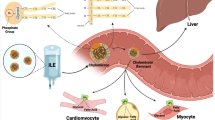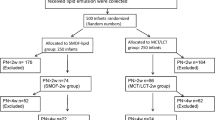Abstract
Background
Intravenous lipid emulsion (IVLE) is an integral part of the total parenteral nutrition (TPN) regimen in neonates. The use of IVLE during sepsis is the subject of controversy because it may interfere with phagocytosis of microbes by macrophages and may lead to significant hypertriglyceridemia.
Objective
This paper aims to study the rate of clearance of bacteria in relation to dose of IVLE administered to preterm infants with blood stream infections (BSIs).
Methods
Preterm infants (mean gestational age ± SD, 32.0 ± 2.5 weeks) with culture-proven BSI and receiving TPN were randomized to two groups. The first group (n = 22) was given the usual dose of IVLE according to a standard protocol (starting from 0.5 g kg−1 day−1 and gradually increased by 1 g kg−1 day−1 to a maximum of 3.5 g kg−1 day−1); in the second group (n = 20), IVLE were restricted at a dose of 1 g kg−1 day−1. Samples for blood cultures were withdrawn every 24 h until a negative culture was obtained. CRP was measured daily until its normalization. Serum triglycerides were monitored daily.
Results
The rate of bacterial clearance was significantly more rapid in the restricted-dose IVLE group compared to the standard-dose group [72 (48–120) versus 144 (72–168) h, p = 0.001]. Daily weight increment was significantly greater in the standard-dose IVLE group compared to the restricted-dose IVLE group [25 (6.9–31.9) versus 0.9 (−3.3–11.7) g, p = 0.0001]. The duration of antibiotic use was significantly reduced in the restricted-dose IVLE group compared with the standard-dose IVLE group (10.0 ± 4.5 vs 14.9 ± 5.1 days; p = 0.003). The durations of TPN, mechanical ventilation, and hospitalization were not significantly different between groups.
Conclusions
Restriction of the dose of IVLE to 1 g kg−1 day−1 in preterm infants with BSI is associated with earlier negative blood cultures and reduced duration of antibiotic therapy but was associated with a lower daily weight increments.


Similar content being viewed by others
References
American Academy of Pediatrics- Committee on Nutrition (1981) Use of intravenous fat emulsion in pediatric patients. Pediatrics 68:738–743
Ballard J, Khoury J, Wedig K et al (1991) New Ballard Score, expanded to include extremely premature infants. J Pediatr 119:417–423
Berger C, Vehlinger J, Ghelfi D et al (1995) Comparison of C-reactive protein and white blood cell count with differential in neonates at risk for septicemia. Eur J Pediatr 154:138–144
Brans YW, Andrew DS, Carrillo DW et al (1990) Tolerance of fat emulsions in very low birthweight neonates: effect of birthweight on plasma lipid concentrations. Am J Perinatol 7:114–117
Buenestado A, Cortijo J, Sanz MJ et al (2006) Olive oil-based lipid emulsion’s neutral effects on neutrophil functions and leukocyte-endothelial cell interactions. J Parenter Enteral Nutr 30:286–296
Celik I, Demirel F, Uras N et al (2010) What are the cut-off levels for IL-6 and CRP in neonatal sepsis? J Clin Lab Anal 24:407–412
Chaudari S, Kadam S (2006) Total parenteral nutrition in neonates. Indian Pediatric 43:953–964
Dahlstrom KA, Goulet OJ, Roberts RL et al (1988) Lipid tolerance in children receiving long-term parenteral nutrition: a biochemical and immunologic study. J Pediatr 113:985–990
Ellard D, Anderson DM (2008) Nutrition. In: Cloherty JP, Eichenwald EC, Stark AR (eds) Manual of neonatal care, vol 5. Lippincott Williams & Wilkins, Philadelphia, pp 114–136
Garnacho Montero J, Shou J, Ortiz Leyba C et al (1996) Lipids and immune function. Nutrit Hosp 11:230–237
Garner J, Jarvis W, Emori T et al (1996) CDC definitions for nosocomial infections. In: Olmstead R (ed) APIC infection control and applied epidemiology: principles and practice. Mosby, St Louis, pp A1–A20
Granato D, Blum S, Rossle C et al (2000) Effects of parenteral lipid emulsions with different fatty acid composition on immune cell functions in vitro. J Parenter Enteral Nutr 24:113–118
Gutcher GR, Farrell PM (1991) Intravenous infusion of lipids for the prevention of essential fatty acid deficiency in the preterm infant. Am J Clin Nutr 54:1024–1028
Haimi-Cohen Y, Vellozzi EM, Rubin LG (2002) Initial concentration of Staphylococcus epidermidis in simulated pediatric blood cultures correlates with time to positive results with the automated. Continuously monitored BACTEC blood culture system. J Clin Microbiol 40:898–901
Herson V, Block C, Eisenfeld L et al (1989) Effects of intravenous fat infusion on neonatal neutrophil and platelet function. J Parenter Enteral Nutr 13:620–622
Kerner JA, Poole RL (2006) The use of IV fat in neonates. Nutr Clin Pract 21:374–380
Koletzko B, Goulet O, Hunt J et al (2005) Guidelines on pediatric parenteral nutrition. J Pediatr Gastroenterol Nutr 41:S1–S4
Koneman EW, Allen SD, Janda WM et al (1997) Introduction to microbiology. Part II: Guidelines for the collection, transport, processing, analysis, and reporting of cultures from specific specimen sources. In: Koneman EW, Allen SD, Janda WM et al (eds) Color atlas of diagnostic microbiology. Lippincot, Philadelphia, pp 121–170
Levene MI, Wigglesworth JS, Desai R (1980) Pulmonary fat accumulation after lipid infusion in the preterm infant. Lancet 2:815–818
Lovegrove JA, Lovegrove SS, Lesauvage SV et al (2004) Moderate fish-oil supplementation reverses low platelet, long-chain n-3 polyunsaturated fatty acid status and reduces plasma triacylglycerol concentrations in British Indo-Asians. Am J Clin Nutr 79:974–982
MGowan MW, Artiss JD, Standbergh DR et al (1983) A peroxidase-coupled method for colorimetric determination of serum triglycerides. Clin Chem 29:538–542
Muller-Pebody B, Johnson AP, Heath PT et al (2011) iCAP Group (Improving Antibiotic Prescribing in Primary Care). Empirical treatment of neonatal sepsis: are the current guidelines adequate? Arch Dis Child Fetal Neonatal Ed 96:F4–F8
National Committee for Clinical Laboratory Standards (2000) Performance standards for antimicrobial disk susceptibility tests, 4th edn, approved standard. NCCLS, Villanova
Nishiwaki H, Iriyama K, Asami H et al (1986) Influences of an infusion of lipid emulsion on phagocytic activity of cultured Kupffer’s cells in septic rats. J Parenter Enteral Nutr 10:614–616
Okada Y, Klein NJ, van Saene HK et al (2000) Bactericidal activity against coagulase-negative staphylococci is impaired in infants receiving long-term parenteral nutrition. Ann Surg 231:276–281
Park W, Paust H, Brosicke H et al (1986) Impaired fat utilization in parenterally fed low-birth-weight infants suffering from sepsis. J Parenter Enteral Nutr 10:627–630
Park W, Paust H, Schroder H (1984) Lipid infusion in premature infants suffering from sepsis. J Parenter Enteral Nutr 8:290–292
Periera GR, Fox WW, Stanley CA et al (1980) Decreased oxygenation and hyperlipemia during intravenous fat infusions in premature infants. Pediatrics 66:26–30
Prasertsom W, Phillipos EZ, Van Aerde JE et al (1996) Pulmonary vascular resistance during lipid infusion in neonates. Arch Dis Child Fetal Neonatal Ed 74:F95–F98
Reimund JM, Scheer O, Muller CD et al (2004) In vitro modulation of inflammatory cytokine production by three lipid emulsions with different fatty acid compositions. Clinics of Nutrition 23:1324–1332
Simoens CM, Deckelbaum RJ, Massaut JJ et al (2008) Inclusion of 10% fish oil in mixed medium-chain triacylglycerol-long-chain triacylglycerol emulsions increases plasma triacylglycerol clearance and induces rapid eicosapentaenoic acid (20:5n-3) incorporation into blood cell phospholipids. Am J Clin Nutr 88:282–288
Sirota L, Straussberg R, Notti I et al (1997) Effect of lipid emulsion on IL-2 production by mononuclear cells of newborn infants and adults. Acta Paediatr 86:410–413
Thureen P (1999) Early aggressive nutrition in the neonate. Pediatr Rev 20:e45–e55
Toce SS, Keenan WJ (1995) Lipid intolerance in newborns is associated with hepatic dysfunction but not infection. Arch Pediatr Adolesc Med 149:1249–1253
Tomsits E, Rischak K, Szollar L (2000) Effects of early nutrition on free radical formation in VLBW infants with respiratory distress. J Am Coll Nutr 19:237–241
Van Aerde JE, Michaelann SW, Feldman M et al (2004) Accretion of lipid in the fetus and newborn. In: Polin RA, Fox WW, Abman SH (eds) Fetal and neonatal physiology, 3rd edn, vol. 1. Saunders, Philadelphia, p 400
Waitzberg DL, Bellinati-Pires R, Salgado MM et al (1997) Effect of total parenteral nutrition with different lipid emulsions of human monocyte and neutrophil functions. Nutrition 13:128–132
Wanten G, Rops A, van Emst-de Vries SE et al (2002) Prompt inhibition of fMLP-induced Camobilization by parenteral lipid emulsions in human neutrophils. J Lipid Res 43:550–556
Ziegler EE, Thureen PJ, Carlson SJ (2002) Aggressive nutrition of the very low birth weight infant. Clin Perinatol 29:225–244
Conflict of interest
None.
Author information
Authors and Affiliations
Corresponding author
Rights and permissions
About this article
Cite this article
Shouman, B., Abdel-Hady, H., Badr, R.I. et al. Dose of intravenous lipids and rate of bacterial clearance in preterm infants with blood stream infections. Eur J Pediatr 171, 811–816 (2012). https://doi.org/10.1007/s00431-011-1619-y
Received:
Accepted:
Published:
Issue Date:
DOI: https://doi.org/10.1007/s00431-011-1619-y




